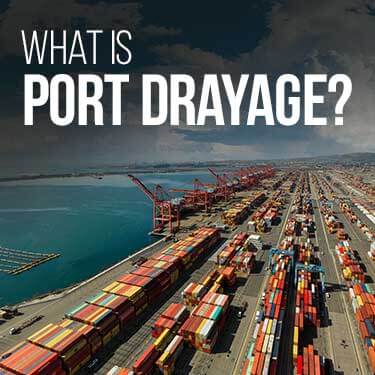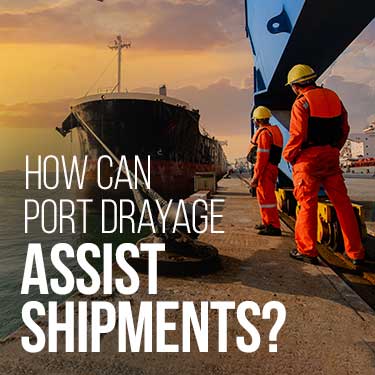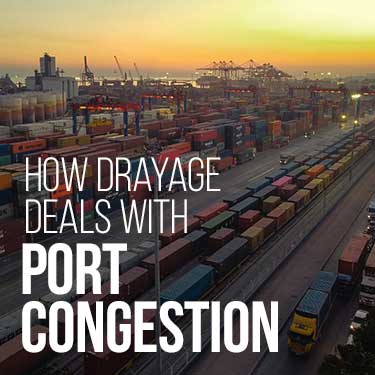In the currently complex and always changing landscape of freight shipment, everyone is searching for relief. Namely, relieving the various ports around the U.S. of their own valuable freight. Congestion and delays lead to many businesses’ goods not making it to shelves, frustrating both themselves and their customers. There’s no simple solution in this area but the possibility exists to somewhat alleviate it by turning to port drayage. But what is port drayage and how can it help you out in your time of need?
Port drayage refers to a truck picking up a shipping container from a cargo port and transporting it over a short distance. Trucks used for drayage shipments must be equipped with a chassis that’s specifically built to carry cargo containers. This logistics task plays a critical role in relieving port congestion.
Below, our guide provides you with a comprehensive look at what port drayage is. We also explore its role in the overall supply chain journey. Finally, we cover what you should look for when considering port drayage services.
If you’re in a hurry and are just looking for a drayage quote, our team is here to help you. Click the link below and request a drayage quote today.

Port drayage dominates most of America’s overseas imports into the country. The three biggest ports in the United States — located in Los Angeles, Long Beach and New York/New Jersey — combine to accept roughly $660 billion in annual container value. Getting these imports out of the port and on the road is a critical task in the overall supply chain journey. Like companies at the moment, ports are still trying to navigate this themselves.
You might be asking yourself what port drayage refers to if it’s so important to the success of freight transportation? As noted above, the term drayage (also known as first mile delivery) explains a short journey where freight is shipped from a port to a nearby location. This brief transportation is meant to connect the port to a facility owned or rented by the business having the goods imported — such as a distribution center or warehouse.
Drayage’s place in the present and future are secure and the following tidbits speak to that reality:
Port drayage operates as a crucial link to keep the supply chain moving in the most efficient way possible. Also, with the recent challenges posed as a result of COVID-19, the role drayage plays in this regard is of increasing importance.
There are six different types of container drayage as defined by the Intermodal Association of North America.
While port drayage is not one of the terms specifically recognized by this organization, all of the kinds listed are at least partially considered as port drayage.
Check out the alternative to port drayage by reading our article on rail drayage.

The vast majority of drayage originates at a U.S. port of entry, so this is something that is mostly associated with ports inherently. Drayage in general is also known as intermodal drayage. This means that the shipping container that enters the port is transported across two or more modes of transport.
An example of a port drayage movement is illustrated below:
Instead of tying up a single driver for an entire day for a trip, the drayage journey keeps things moving. Both customers and their freight moving partners are beginning to explore using that same truck to make several shorter trips over the same timeframe. Whether it’s during normal daily shipping or the middle of the holiday rush, most freight is time-sensitive to one degree or another.

Ocean ports are beyond capacity for numerous reasons for the foreseeable future. Along with the present-day freight disruption, the congestion doesn’t appear to be going away anytime soon. Yet, some are confident it will be fixed sooner rather than later.
Still, drayage — along with other modes of transport such as transloading and intermodal — can partially be of aid in the right spots. When executed properly, these logistics approaches can alleviate a small amount of the pressure on the supply chain.
Drayage can relieve port congestion in the following ways:
So port drayage by itself isn’t going to solve all of the problems that the supply chain is seeing from the time ocean vessels arrive off the United States’ shores. But it can absolutely play a key part in assisting to some degree.
One of the best parts about drayage is that help is available to plan and forecast how it can work for your unique situation. However, that only comes from working with a proven and reliable third-party logistics (3PL) company. A 3PL can assist you in expertly utilizing port drayage only when it stands to benefit you.
In reference to the planning, if you contact a 3PL they can determine if drayage from the port would be beneficial for you. Based on your situation, they can identify if drayage would improve your commodities’ ability to exit the port more quickly. They’ll also be able to assist in finding a nearby facility to send the container to if you don’t have access to one.
The reality of the supply chain also lends itself to a 3PL company being involved. Many 3PL’s, including ourselves, offer customs clearance services. Being able to rely on a single partner for the entirety of the process allows the entire interaction to be streamlined. If you have a problem at the port, need advice or just don’t want a bunch of different partners to deal with, then you have a single place to turn to.
Having your port drayage service handled properly can truly be the difference between your freight being stuck in place and it moving exactly where it’s needed. In order to make sure port drayage works properly, you’ll need a progressive 3PL. This is where R+L Global Logistics comes in to both guide and carry out the entire shipping process.
R+L Global Logistics can do it all. From planning and forecasting to importing and shipping all of your valuable commodities, we’ve got you covered. No matter what challenges your supply chain is facing, we're equipped to solve them. We’ve recently purchased additional chassis to help complete drayage orders, so you won’t be stuck wondering if your freight can be moved.
So if you think you might require port drayage service, ensure that you get the best value and coverage possible by choosing to go with R+L Global Logistics. Request a quote or give us a call today at (866) 353-7178.
R+L Global Logistics
315 NE 14th St., Ocala, FL 34470